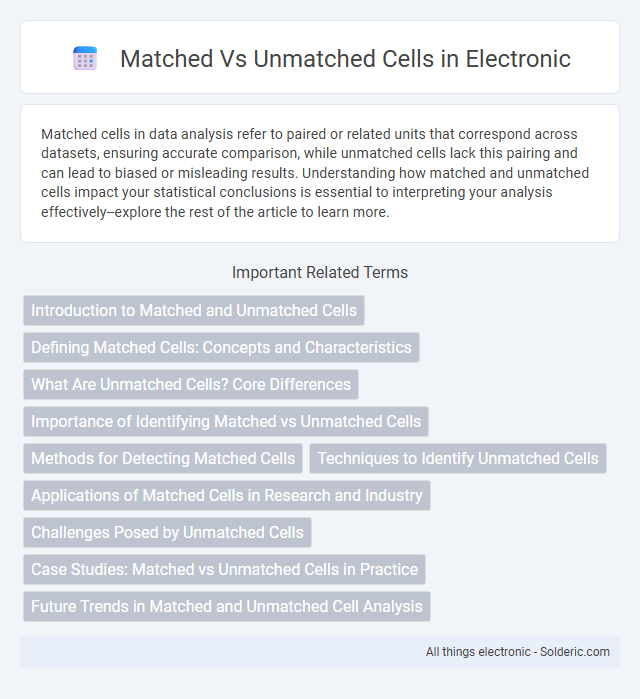Matched cells in data analysis refer to paired or related units that correspond across datasets, ensuring accurate comparison, while unmatched cells lack this pairing and can lead to biased or misleading results. Understanding how matched and unmatched cells impact your statistical conclusions is essential to interpreting your analysis effectively--explore the rest of the article to learn more.
Comparison Table
| Criteria | Matched Cells | Unmatched Cells |
|---|---|---|
| Definition | Cells paired based on similarity or criteria | Cells without a corresponding pair or match |
| Data Consistency | High - ensures data integrity and accuracy | Low - potential outliers or errors |
| Usage | Used in data validation, merging, and syncing tasks | Requires identification and review for resolution |
| Impact on Analysis | Improves reliability and comparability of results | May distort analysis; can cause incomplete datasets |
| Handling Approach | Direct processing or aggregation | Flagging, correction, or exclusion needed |
Introduction to Matched and Unmatched Cells
Matched cells refer to pairs of data points that correspond directly across two datasets, often used to control for confounding variables in statistical analysis. Unmatched cells represent independent data points without a direct counterpart, commonly found in cross-sectional studies lacking paired observations. Understanding the distinction between matched and unmatched cells is crucial for selecting appropriate statistical tests and ensuring the validity of your analysis.
Defining Matched Cells: Concepts and Characteristics
Matched cells refer to paired samples in experimental or observational studies where each subject or unit in one group is systematically paired with a corresponding unit in another group based on specific key characteristics or criteria. These pairs share similar attributes such as age, gender, or baseline measurements, reducing variability and enhancing the accuracy of comparisons between treatments or conditions. The main characteristic of matched cells is their role in controlling confounding variables, thereby increasing the statistical power and reliability of the study's outcomes.
What Are Unmatched Cells? Core Differences
Unmatched cells are data entries in a dataset or spreadsheet that do not have corresponding pairs or matches in another related dataset, often due to discrepancies in key identifiers or missing information. The core differences between matched and unmatched cells lie in their relational status: matched cells have identifiable counterparts across datasets, ensuring data consistency and accuracy, while unmatched cells indicate anomalies or gaps requiring correction for proper data integration. Understanding unmatched cells helps you identify errors, improve data quality, and streamline database management processes.
Importance of Identifying Matched vs Unmatched Cells
Identifying matched vs unmatched cells is crucial for accurate data integration and analysis in single-cell sequencing studies, enabling researchers to distinguish between shared and unique cellular populations across samples. This distinction improves the reliability of downstream analyses such as differential expression, cellular heterogeneity assessment, and cell-type annotation. Accurate classification of matched and unmatched cells supports robust biological insights and enhances the interpretation of cellular dynamics and disease mechanisms.
Methods for Detecting Matched Cells
Methods for detecting matched cells in single-cell data integration often involve computational algorithms such as mutual nearest neighbors (MNN) and canonical correlation analysis (CCA). These techniques identify shared cell populations by aligning features across datasets, ensuring accurate comparison of cellular states. You can enhance data quality by selecting tools that robustly detect matched cells, improving downstream analysis outcomes.
Techniques to Identify Unmatched Cells
Techniques to identify unmatched cells include data comparison algorithms like fuzzy matching, exact matching, and rule-based matching to detect discrepancies between datasets. Visualization tools such as heatmaps and scatter plots help highlight unmatched entries for manual review. Automated matching software often incorporates machine learning models to improve accuracy in identifying unmatched cells across complex data sources.
Applications of Matched Cells in Research and Industry
Matched cells are extensively utilized in biomedical research and pharmaceutical development to ensure precise comparison of cellular responses under controlled conditions. Their application enhances the reliability of experimental outcomes in drug screening, toxicity testing, and disease modeling by reducing variability caused by genetic or environmental factors. Industries leverage matched cell models to accelerate biomarker discovery, improve personalized medicine approaches, and optimize therapeutic interventions.
Challenges Posed by Unmatched Cells
Unmatched cells in data matching processes create significant challenges, such as increased error rates and reduced data integrity, complicating accurate analysis and reporting. These cells often result from inconsistencies in data entry, missing values, or differences in formatting across datasets, which hinder seamless integration and comparison. Managing unmatched cells requires advanced algorithms and robust preprocessing techniques to improve matching accuracy and maintain the reliability of combined data sources.
Case Studies: Matched vs Unmatched Cells in Practice
Case studies highlight how matched cells improve accuracy by controlling confounding variables, leading to more reliable comparisons in clinical trials. Unmatched cells, though easier to implement, may introduce bias due to variability in sample characteristics, affecting your study's validity. Selecting matched or unmatched designs depends on the research goal and available data quality.
Future Trends in Matched and Unmatched Cell Analysis
Future trends in matched and unmatched cell analysis emphasize enhanced single-cell sequencing technologies that improve accuracy and resolution in comparing cellular states. Machine learning algorithms are increasingly applied to decipher complex biological patterns in both matched and unmatched datasets, accelerating discoveries in personalized medicine. Your research can benefit from integrating multimodal data sources, enabling comprehensive insights into cellular heterogeneity and disease progression.
Matched vs Unmatched cells Infographic

 solderic.com
solderic.com